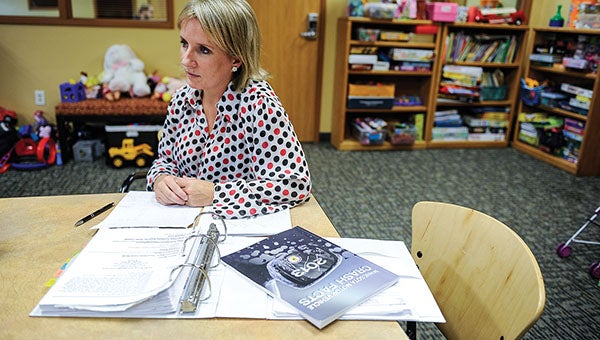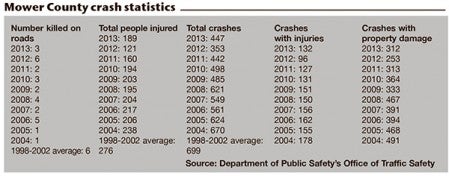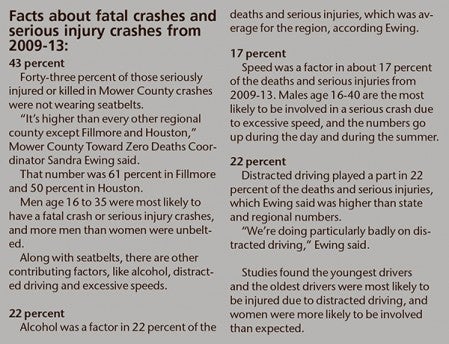‘It’s just very preventable’
Published 6:59 am Monday, October 20, 2014

Sandra Ewing is the Toward Zero Deaths coordinator for Mower County. Friday she talked about road safety and what the numbers mean. Eric Johnson/photodesk@austindailyherald.com
Eric Johnson/photodesk@austindailyherald.com
Sandra Ewing once defended a truck driver who dozed off at the wheel and struck a vehicle. A father had pulled to the side of the road after a soccer match to “answer nature’s call” while his two sons slept in the vehicle. The truck driver drifted off the road, hit the parked vehicle and killed one of the two children.

“That whole family was devastated, but there was also the truck driver, who was just a regular bloke and had just dozed off at the wheel,” Ewing said.
The driver hit the bottle, lost his job and descended into financial difficulties and depression.
That’s just one of many similar stories Ewing saw as a defense attorney in her native England. After more than a decade addressing the aftermath of fatal crashes and serious injuries, Ewing is now focused on prevention as Mower County’s Toward Zero Deaths coordinator.
“It’s all so totally avoidable,” she said of serious crashes. “It really is.”
Ewing started as the Toward Zero Deaths coordinator for Mower County Sept. 1, and she’s also working at the Michael H. Seibel Family Visitation and Exchange Center.
Ewing said stories like the one about the truck driver are a key way to connect with the public.
To Ewing, it’s important for people to think beyond fines and to understand the implications of not wearing a seatbelt, of distracted driving and of drunk driving.
While she’s a proponent of using shocking photographs and advertisements to show drivers what can happen in fatal crashes, she wasn’t sure that’s the most effective approach.

“I think people have seen pictures, though,” she said. “I think you have to show them the human stories.”
She cited video series about distracted driving that shows people who’ve been affected by someone texting and driving.
Social pressures
Last week, Ewing visited with the Mower County board to discuss Toward Zero Deaths messages, which she also planned to share with the Austin City Council on Monday. She told the board a story of driving in England, where it’s illegal to talk on the phone while driving. She recalled being on her phone while driving and having another driver honk at her.
To Ewing, that’s another way to change behavior: social pressure.
“That’s the sort of thing that I think changes behavior,” she said.
In Minnesota, drivers can talk on their phones, but they can’t text or email. Ewing still finds that strange, as mobile phones are banned when driving in England.
“My view is until you get both of those in line with each other where you cannot use a mobile phone it’s kind of a mixed message,” she said.
Minnesota Department of Transportation statistics show more serious injuries and fatal crashes stemming from distracted driving occur between 7 a.m. and 6 p.m., which to Ewing suggests work-related texting and emailing.
Because of that, state officials are pushing for employers to ban employees from using their mobile phones when driving on company business.
The social pressure, Ewing said, can also get stronger when it comes to drunk driving. However, drivers face a challenge in Minnesota when it comes to drunk driving: lack of transportation.
In London, Ewing said people often take a taxi or the bus to pubs or bars. Here, especially for rural and many small town residents, that’s not an option. A couple must often choose between staying in or for one person not to drink.
“It’s much more difficult in rural communities,” Ewing said. “The distances are bigger. People would end up paying quite a bit of money for a taxi to the place that they’re going to and the taxi back. That’s the difficulty.”
Some counties are utilizing a plan called Joyride, which offers sober rides to get people home without drinking.
In 2012, Austin tested a plan called “The Big Red Ride Home,” but the Austin City Council voted down funding and it didn’t continue.
Other communities are offering similar rides, but they’re not just funded by public dollars. Bars have picked up part of the bill and patrons must pay a per ride fee.
“That’s the challenge is giving people an alternative means of transportation,” Ewing said.
Prevention
Having seen the other side of crashes, Ewing continues to stress prevention.
Fatal crashes, in Ewing’s experiences, are crippling not only for the families of the deceased, but for others involved in the crash too, especially the parties responsible for the crash.
“I’ve seen the ripple effect of a fatal,” she said. “It doesn’t only affect the deceased’s family.”
Distracted driving and alcohol are key contributing factors, as is complacency and even familiarity.
In Minnesota, 82 percent of deaths occur on rural roads, and Ewing said single-lane roads are the most dangerous. Since people often traverse the same stretches of roads and can become complacent, Ewing urged people to live in the moment while driving, which also means they need to be aware of their surroundings.
Ewing noted state officials prefer the term “crashes” to “accidents” because there’s almost always a reason.
“It’s just very preventable,” she said.

